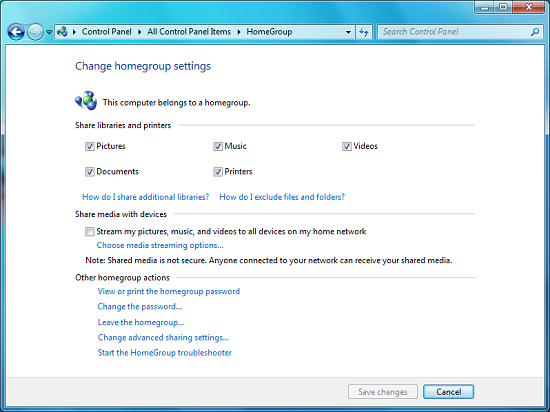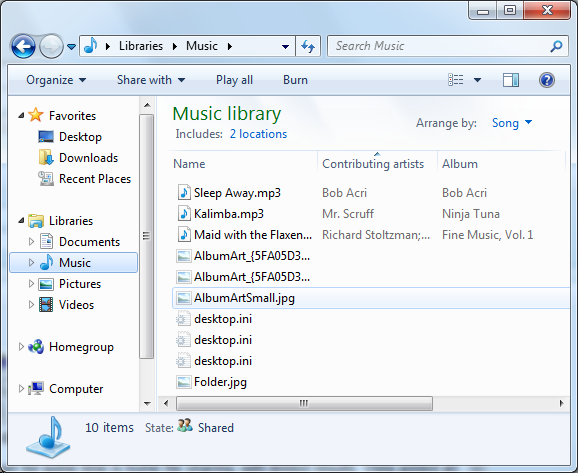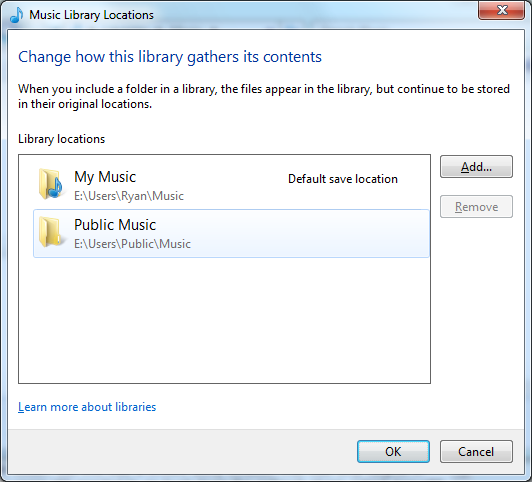Windows 7: Release Candidate 1 Preview
by Ryan Smith and Gary Key on May 5, 2009 11:00 PM EST- Posted in
- Systems
Libraries and Homegroups: New Ways to Organize and Share
Something Microsoft has been trying to conquer for some time is home file sharing, with limited results. Vista added an easy way to turn on network sharing of the Public folder, but this was a limited utility solution that was only helpful in sharing items specifically placed there, and other users still needed to go hunt down the network share (which brought plenty of problems of its own). Network shares are inherently a client-server design, while for home file sharing you need something closer to a peer-to-peer design.
With Windows 7 Microsoft appears to have finally gotten this right with the addition of two new features; Homegroups and Libraries. Homegroups are in essence auto-configuring network shares designed to act like a peer-to-peer network. When the first Windows 7 machine is added to a network, the user can choose to create a Homegroup along with what libraries they wish to share. Any libraries they choose to share will be opened up with read-only access to everyone else in the Homegroup, with Homegroup access limited by a shared alphanumeric password created along with the Homegroup.

Homegroup Configuration
Sitting on top of the Homegroup is the Windows 7 Libraries feature. Libraries in this case are a kind of meta-folder for various types of files, listing the contents of several different locations as if they were all in the same local folder. In turn Windows treats a library as a local folder and includes all the contents of a library in a regular search, or when browsing through files on Windows Media Player/Center, etc. Windows 7 comes with four libraries by default: Documents, Music, Videos, and Pictures. As there’s nothing special about a library other than where they search, any number of additional libraries may be created and shared.

Viewing the Music Library
The ultimate purpose for libraries is that they basically allow for the transparent integration of network shares, and this in turn is what makes Homegroups work. Once a computer has joined a Homegroup, its shared libraries become available as additional libraries, making the use of shared files largely transparent. In turn these remote libraries can be added to the local libraries, making the process fully transparent. Libraries can also be manually adjusted, allowing for files in other locations (local and remote) to be added to a library, although only local material is shared with a Homegroup. For the same reasons, this also solves the integration issues of Windows Home Server – Home Server shares can be added to a library, and made equally transparent.

Configuring A Library
It should also be noted that the meta-folder concept of libraries works in reverse too. Besides bringing together files from multiple locations, it’s a valid (and default) place to save files. In this case every library has a single defined “default save location” where all documents saved to that library actually get written to. By default, these locations are the regular folders inside of the user’s home directory.
In households with multiple computers, we’d expect that Homegroups turn out to be one of Windows 7’s most popular features given how easily we were able to set a group up and how well it worked in our testing. Libraries may be a hard sale however for users without multiple computers due to inertia, even if they’re still extremely useful for local-only use. We’ll have to see how this plays out.










121 Comments
View All Comments
Jman13 - Friday, May 8, 2009 - link
I installed the x64 version of RC1 last night. Painless install, and VERY fast. Much faster than my XP install. I'm talking about actual usage of the computer, not the install (though that was fast too). I skipped Vista, but Win7 really looks to be a very good OS. Some of the usability features in Win7 are really nice (half screen docking to the side, for instance. I'm now using RC1 as my main OS, and likely will stay that way until the actual release, where I will finally upgrade from XP.I'm very pleased.
Jackattak - Friday, May 8, 2009 - link
Mine also went completely as planned last night. I loaded it onto my Dell XPS420 on a spare 160GB HD I had in there.Painless, flawless, and runs like a dream (as does Vista, so that was to be expected).
Loaded the 185 drivers from nVidia for my 8800GT 512MB, installed Left 4 Dead (and Steam), and played for an hour without any issues at all.
Lovin' the new UI. Hopefully it gets even cooler when the retail release comes out, but I doubt they'll make any drastic changes by then as there would be lots of RC users taken aback.
Great work so far, M$. Keep it up.
~Jackattak
Grandpa - Friday, May 8, 2009 - link
I absolutely hate the menu in Win 7. 3 to 4 clicks to open a program that would only take 1 click in XP or Vista. Also, in Control Panel, there is no option for the Classic look there. I don't see any performance boost over Vista whatsoever. There just isn't a good reason to pay good money for this. Linux is a much better value.Jman13 - Friday, May 8, 2009 - link
There's an option for the classic look. Just change the view to large or small icons in the upper right corner.Grandpa - Monday, May 11, 2009 - link
It isn't just the look. When you hover over the folder you want to open, it doesn't open unless you click ( even though the option for that to happen is checked ).PS: I have used Linux. It's just a little difficult to play the games I like playing with it.
B3an - Friday, May 8, 2009 - link
Oh look a linux fanboy bashing Win7. Like your've even fucking tried it.HellcatM - Thursday, May 7, 2009 - link
I thought Vista was ok, I liked the start menu and it just bets better with Windows 7. I find things just as easy as well, if not easier because I can just type in the search.I think setting up a network, wireless and a printer is much easier too. I haven't tested home network because I don't have two computers computers to test it on. I like the idea though.
The UI I like, the launch bar is good. I'm just wondering if Microsoft is going to do a UI change for the gold release. My thought is they know that since they did an open beta they way they did where anyone can use it, that people at Apple are going to be looking at it really closely and they'll make changes to Mac OS. With a UI change it'll give a curveball to Apple. Maybe MS has a major jaw dropping UI change. I just don't think their going to take a chance that Apple is going to test Win 7 and not make changes to their own. I know if I were Apple I would.
I think Windows 7 is ready now. Its a strong OS and I haven't had any major problems. Its quick, has some nice features, and it looks nice.
Jackattak - Thursday, May 7, 2009 - link
Loved it. I have downloaded both the x64 and x86 versions and will be installing them tonight.My one comment on OS brands (I use all of them for one thing or another at work and at home):
When Apple has a serious market share in the personal computing world and can truly develop an operating system for use on hardware from thousands (millions?) of different manufacturers, THEN (and only then) Microsoft will have a problem. Until then, Microsoft will continue to rule the planet, complainers and whiners be damned.
Apple has no serious market share in the home or business.
Linux is for computer professionals and tinkerers.
Microsoft is for the other 97% of the world.
:D
~Jackattak
DrRap - Thursday, May 7, 2009 - link
windows has left the building guyshttp://www.youtube.com/watch?v=wVM32aEABGY&fea...">http://www.youtube.com/watch?v=wVM32aEABGY&fea...
Techno Pride - Thursday, May 7, 2009 - link
I don't get it. It's just an OS, a tool. Does it really matter what brand of hammer you use?Shouldn't it matter more whether any tangible results are produced using whatever tools are available?